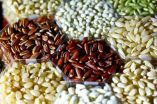(Press-News.org) The open-access, open-data journal GigaScience (published by BGI and Biomed Central), announces today the publication of an article on the genome sequencing of 3000 rice strains along with the release of this entire dataset in a citable format in journal's affiliated open-access database, GigaDB. The publication and release of this enormous data set (which quadruples the current amount of publicly available rice sequence data) coincides with World Hunger Day to highlight one of the primary goals of this project— to develop resources that will aid in improving global food security, especially in the poorest areas of the world. This work is the completion of stage one of the 3000 Rice Genomes Project, a collaborative effort made up of the Chinese Academy of Agricultural Sciences (CAAS), the International Rice Research Institute (IRRI), and BGI, and is funded by the Bill and Melinda Gates Foundation and the Chinese Ministry of Science and Technology.
With more than 1/8th of the world's population living in extreme hunger and poverty, and an every-increasing world population (estimated to reach 9.6 billion by 2050), there is a huge need to create new resources to improve crop yield, reduce the impact of agricultural practices on the environment, and develop food crops that are of high yield and nutrition and can grow successfully in environments stressed by drought, pests, diseases, or poor soil quality. While rice research has greatly advanced since the completion of the first high-quality rice genome sequence in 2005, there has been limited change in breeding practices that are important for producing improved and better adapted rice strains.
The 3000 Rice Genomes Project provides a major step forward for addressing these challenges by creating and releasing an extensive amount of genetic information that can ultimately be applied to intelligent breeding practices, which take advantage of the natural variation between different plant strains and information on the genetic mechanisms that underlie these traits to select strains for breeding that will be more successful in producing hybrid strains with characteristics that are highly suited for growing successfully in different environments.
Dr. Zhikang Li, the Project Director at CAAS, stated that the 3000 Rice Genomes Project is part of an ongoing effort to provide resources specifically for poverty-stricken farmers in Africa and Asia, aiming to reach at least 20 million rice farmers in 16 target countries (8 African and 8 Asian countries). "Rice is the staple food for most Asian people, and has increasing consumption in Africa," said Dr. Li. "With decreasing resources (water and land), food security is —and will be— the most challenging issue in these countries, both currently and in the future. As a scientist in rice genetics, breeding and genomics, it would be a dream to help to solve this problem."
Dr. Jun Wang, Director of BGI, added to this, saying that, "the population boom and worsening climate crisis have presented big challenges on global food shortage and safety. BGI is dedicated to applying genomics technologies to make a fast, controllable and highly efficient molecular breeding model possible. This opens a new way to carry out agricultural breeding. With the joined forces with CAAS, IRRI and Gates Foundation, we have made a step forward in big-data-based crop research and digitalized breeding. We believe every step will get us closer to the ultimate goal of improving the wellbeing of human race."
According to IRRI director general Dr. Robert Zeigler, "access to 3,000 genomes of rice sequence data will tremendously accelerate the ability of breeding programs to overcome key hurdles mankind faces in the near future." This collaborative project, added Zeigler, "will add an immense amount of knowledge to rice genetics, and enable detailed analysis by the global research community to ultimately benefit the poorest farmers who grow rice under the most difficult conditions."
Drs, Wang and Zeigler, and Dr. Jia-Yang Li, President of CAAS, provide further information on the goals of this project in an accompanying commentary in GigaScience.
To reach their goals, the three-institute collaboration has not only released 13.4 terabytes of data, they have also collected seeds from each strain (available in the International Rice Genebank Collection housed at IRRI). Having banked seeds is essential to make full use of these now genetically defined strains to develop and sustain the most appropriate hybrid strains for different environments. There remains, however, one additional component to achieve this goal: this is information that allows researchers and breeders to directly link the genetic information (genotype) to the physical traits (phenotype) of these different strains. This requires careful assessment and curation of each rice strain for agriculturally important traits, which can then be linked to genetic markers in the now available genome sequences.
Current breeding practices, which have essentially remained the same since the development of agriculture, typically use apparent physical traits to guide strain selection for crossbreeding with the hope that the offspring will manifest a combination and improvement of the desired traits, such as drought, pest and disease resistance and increased crop productivity and improved nutritional value. However, the underlying genetic makeup can often confound breeder expectations because unknown genetic interactions can block, modify, or alter the development of the selected physical characteristics when two strains are bred. Thus, trial and error and multiple successive breeding stages are often required.
Having full knowledge of the genetic makeup of a plant allows researchers to identify genetic markers related to specific physical traits, and better understand how different genetic interactions effect plant phenotypes. This information allows a breeder to make more intelligent choices in strain selection, resulting in more accurate and rapid development of rice strains that are better suited to different agricultural environments in poor and environmentally stressed economies.
This is a process that requires a great deal of care and manpower. Thus, the release of these data, and making the genetic information freely available to plant breeders and scientists across the world, will greatly aid in defining genotype/phenotype relationships as well as serve as an extensive resource improving our understanding of plant biology.
Publication in GigaScience includes storage of relevant associated data in the journal's affiliated database, GigaDB, where every dataset is provided with a digital object identifier (DOI), making it possible to cite, find and track data in standard scientific literature, which serves as a strong incentive for researchers to more rapidly release expensive and work-intensive datasets for community use. On top of hosting the terabytes of supporting data in GigaDB, to provide the most extensive availability to the community, the sequence reads for this project have also been submitted to the SRA repository at PRJEB6180.
INFORMATION:
Further Reading
The 3,000 Rice Genomes Project. The 3,000 Rice Genomes Project. GigaScience 3:7 http://dx.doi.org/10.1186/2047-217X-3-7
Li, J-Y, Wang, J. and Zeigler The 3000 Rice Genomes Project: new opportunities and challenges for future rice research. GigaScience 2014, 3:8 http://dx.doi.org/10.1186/2047-217X-3-8
The 3000 Rice Genomes Project (2014): The Rice 3000 Genomes Project Data. GigaScience Database. http://dx.doi.org/10.5524/200001
International Rice Genebank Collection: http://irri.org/our-work/research/genetic-diversity/international-rice-genebank
About World Hunger Day: http://www.thehungerproject.co.uk/getinvolved/worldhungerday/world-hunger-day-purpose/
About GigaScience
GigeScience is co-published by BGI, the world's largest genomics organization, and BioMed Central, the world's first open-access publisher. The journal covers research that uses or produces 'big data' from the full spectrum of the life sciences. It also serves as a forum for discussing the difficulties of and unique needs for handling large-scale data from all areas of the life sciences. The journal has a completely novel publication format — one that integrates manuscript publication with complete data hosting, and analyses tool incorporation. To encourage transparent reporting of scientific research as well as enable future access and analyses, it is a requirement of manuscript submission to GigaScience that all supporting data and source code be made available in the GigaScience database, GigaDB , as well as in their publicly available repositories. GigaScience can provide users access to associated online tools and workflows, and includes an integrated data analysis platform, GigaGalaxy, maximizing the potential utility and re-use of data. (Follow us on twitter @GigaScience; Facebook, and keep up-to-date from our blog.
3,000 rice genome sequences made publicly available on World Hunger Day
The 3000 Rice Genomes Project, a collaboration between the Chinese Academy of Agricultural Sciences, the International Rice Research Institute, and BGI, provides a massive rice genomic sequence resource for worldwide use
2014-05-28
ELSE PRESS RELEASES FROM THIS DATE:
High-status co-eds use 'slut discourse' to assert class advantage
2014-05-28
WASHINGTON, DC, May 27, 2014 — A new study suggests that high-status female college students employ "slut discourse" — defining their styles of femininity and approaches to sexuality as classy rather than trashy or slutty — to assert class advantage and put themselves in a position where they can enjoy sexual exploration with few social consequences.
"Viewing women only as victims of men's sexual dominance fails to hold women accountable for the roles they play in reproducing social inequalities," said lead author Elizabeth A. Armstrong, an associate professor of sociology ...
Prehistoric birds lacked in diversity
2014-05-28
Birds come in astounding variety—from hummingbirds to emus—and behave in myriad ways: they soar the skies, swim the waters, and forage the forests. But this wasn't always the case, according to research by scientists at the University of Chicago and the Field Museum.
The researchers found a striking lack of diversity in the earliest known fossil bird fauna (a set of species that lived at about the same time and in the same habitat). "There were no swans, no swallows, no herons, nothing like that. They were pretty much all between a sparrow and a crow," said Jonathan ...
Cod bones reveal 13th century origin of global fish trade
2014-05-28
London's international fish trade can be traced back 800 years to the medieval period, according to new research published today in the journal Antiquity.
The research, led by archaeologists from UCL, Cambridge and UCLan, provides new insight into the medieval fish trade and the globalisation of London's food supply.
Archaeologists analysed data from nearly 3,000 cod bones found in 95 different excavations in and around London. They identified a sudden change in the origin of the fish during the early 13th century, indicating the onset of a large-scale import trade.
Lead ...
Butterfly 'eyespots' add detail to the story of evolution
2014-05-28
CORVALLIS, Ore. – A new study of the colorful "eyespots" on the wings of some butterfly species is helping to address fundamental questions about evolution that are conceptually similar to the quandary Aristotle wrestled with about 330 B.C. – "which came first, the chicken or the egg?"
After consideration, Aristotle decided that both the egg and the chicken had always existed. That was not the right answer. The new Oregon State University research is providing a little more detail.
The study, published today in Proceedings of the Royal Society B, actually attempts to ...
Should sugary drinks carry a health warning?
2014-05-28
In a personal view published on bmj.com today, a professor of public health at a leading university thinks there should be health warning labels on sugary drinks.
Professor Simon Capewell, professor at the University of Liverpool, highlights that the State of California is considering a new health bill. One which will see sugary drinks labelled with health warnings, vending machines to bear warning labels, and fines of between $50 and $500 per failed inspection".
Professor Capewell thinks this is a good idea, and one that the UK public would support.
He says that ...
Higher NHS spending in deprived areas can reduce health inequalities
2014-05-28
A policy of higher NHS spending in deprived areas compared with affluent areas is associated with a reduction in absolute health inequalities from causes amenable to healthcare in England, suggests a study published on bmj.com today.
In 1999, the government introduced a new 'health inequalities' objective for the allocation of NHS resources in England, which resulted in greater NHS spending in deprived areas with the worst health outcomes. But it is not known whether this policy was successful in contributing to a reduction in health inequalities.
So researchers based ...
School scheme unable to boost healthy eating and activity among kids
2014-05-28
A school-based scheme to encourage children to eat healthily and be active has had little effect, conclude researchers in a study published on bmj.com today.
The findings have relevance for researchers, policy makers, public health practitioners, and doctors, and they suggest that more intense interventions may be required.
Low levels of physical activity and of fruit and vegetable consumption in childhood are associated with adverse health outcomes. School based interventions have the potential to reach the vast majority of children, and evidence reviews have suggested ...
Barriers to HIV testing in older children
2014-05-28
Concerns about guardianship and privacy can discourage clinics from testing children for HIV, according to new research from Zimbabwe published this week in PLOS Medicine. The results of the study, by Rashida A. Ferrand of the London School of Hygiene & Tropical Medicine and colleagues, provide much-needed information on how to improve care of this vulnerable population.
More than three million children globally are living with HIV (90% in sub-Saharan Africa) and in 2011 an estimated 1000 infant infections occurred every day. HIV acquired through mother-to-child transmission ...
Making research findings freely available is an essential aid to medical progress
2014-05-28
In a PLOS Medicine guest editorial, Paul Glasziou, Professor of Evidence-Based Medicine at Bond University in Australia, explores how open access publications could help moderate and reduce the vast waste of global medical research.
Continuing on from his previous work, which highlighted how most of the world's expenditure on medical research was thrown away, Glasziou outlines how bad the situation is and suggests how it might be improved. Subscription-based academic journals make money by through copyrights assigned by authors to publishers who lock the articles behind ...
Dealing with stress -- to cope or to quit?
2014-05-28
Cold Spring Harbor, NY – We all deal with stress differently. For many of us, stress is a great motivator, spurring a renewed sense of vigor to solve life's problems. But for others, stress triggers depression. We become overwhelmed, paralyzed by hopelessness and defeat. Up to 20% of us will struggle with depression at some point in life, and researchers are actively working to understand how and why this debilitating mental disease develops.
Today, a team of researchers at Cold Spring Harbor Laboratory (CSHL) led by Associate Professor Bo Li reveals a major insight ...
LAST 30 PRESS RELEASES:
Injectable breast ‘implant’ offers alternative to traditional surgeries
Neuroscientists devise formulas to measure multilingualism
New prostate cancer trial seeks to reduce toxicity without sacrificing efficacy
Geometry shapes life
A CRISPR screen reveals many previously unrecognized genes required for brain development and a new neurodevelopmental disorder
Hot flush treatment has anti-breast cancer activity, study finds
Securing AI systems against growing cybersecurity threats
Longest observation of an active solar region
Why nail-biting, procrastination and other self-sabotaging behaviors are rooted in survival instincts
Regional variations in mechanical properties of porcine leptomeninges
Artificial empathy in therapy and healthcare: advancements in interpersonal interaction technologies
Why some brains switch gears more efficiently than others
UVA’s Jundong Li wins ICDM’S 2025 Tao Li Award for data mining, machine learning
UVA’s low-power, high-performance computer power player Mircea Stan earns National Academy of Inventors fellowship
Not playing by the rules: USU researcher explores filamentous algae dynamics in rivers
Do our body clocks influence our risk of dementia?
Anthropologists offer new evidence of bipedalism in long-debated fossil discovery
Safer receipt paper from wood
Dosage-sensitive genes suggest no whole-genome duplications in ancestral angiosperm
First ancient human herpesvirus genomes document their deep history with humans
Why Some Bacteria Survive Antibiotics and How to Stop Them - New study reveals that bacteria can survive antibiotic treatment through two fundamentally different “shutdown modes”
UCLA study links scar healing to dangerous placenta condition
CHANGE-seq-BE finds off-target changes in the genome from base editors
The Journal of Nuclear Medicine Ahead-of-Print Tip Sheet: January 2, 2026
Delayed or absent first dose of measles, mumps, and rubella vaccination
Trends in US preterm birth rates by household income and race and ethnicity
Study identifies potential biomarker linked to progression and brain inflammation in multiple sclerosis
Many mothers in Norway do not show up for postnatal check-ups
Researchers want to find out why quick clay is so unstable
Superradiant spins show teamwork at the quantum scale
[Press-News.org] 3,000 rice genome sequences made publicly available on World Hunger DayThe 3000 Rice Genomes Project, a collaboration between the Chinese Academy of Agricultural Sciences, the International Rice Research Institute, and BGI, provides a massive rice genomic sequence resource for worldwide use



